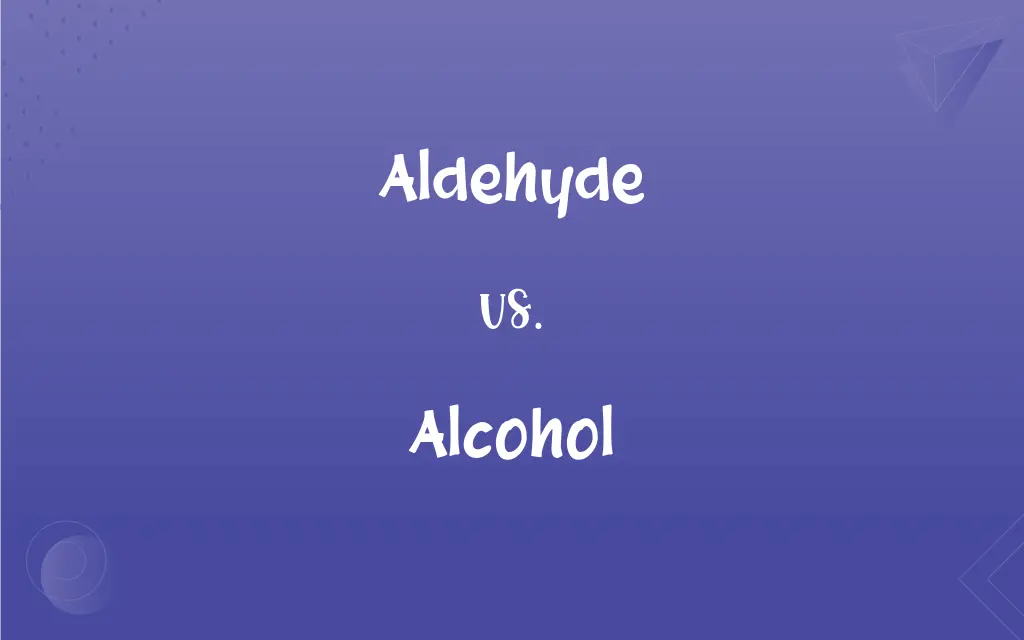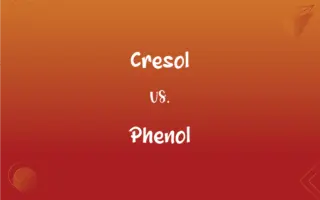Aldehyde vs. Alcohol: What's the Difference?
Edited by Harlon Moss || By Janet White || Published on January 29, 2024
Aldehydes contain a carbonyl group bonded to at least one hydrogen, whereas alcohols have a hydroxyl group (-OH) attached to a carbon atom.

Key Differences
Aldehydes are organic compounds characterized by the presence of a carbonyl group (C=O) where the carbon atom is bonded to a hydrogen and another side chain. Alcohols, in contrast, are characterized by the presence of a hydroxyl group (-OH) attached to a carbon atom.
The reactivity of aldehydes is largely due to their carbonyl group, making them susceptible to oxidation and addition reactions. Alcohols are versatile in reactions, being able to be oxidized to aldehydes or ketones, and can participate in dehydration and substitution reactions.
Aldehydes are typically found in fragrances, flavorings, and as intermediates in chemical synthesis. Alcohols have a broader range of applications, including as solvents, in beverages, antiseptics, fuels, and in the manufacture of other chemicals.
The structure of aldehydes affects their physical properties like boiling point and solubility. Similarly, the structure of alcohols influences their properties, with smaller alcohols being highly soluble in water and volatile.
Simple aldehydes like formaldehyde have a strong, pungent odor, while complex aldehydes are found in essential oils and fragrances. Alcohols range from the toxic methanol to the intoxicating ethanol, and to complex polyols used in various industries.
ADVERTISEMENT
Comparison Chart
Functional Group
Carbonyl group (C=O) with a bonded hydrogen
Hydroxyl group (-OH)
Reactivity
Susceptible to oxidation and addition reactions
Can be oxidized, undergo dehydration and substitution
Common Uses
Fragrances, flavorings, chemical synthesis
Solvents, beverages, antiseptics, fuels
Physical Properties
Affected by carbonyl group; typically have distinctive odors
Solubility and volatility influenced by hydroxyl group
Examples
Formaldehyde, acetaldehyde, benzaldehyde
Methanol, ethanol, isopropanol, glycerol
ADVERTISEMENT
Aldehyde and Alcohol Definitions
Aldehyde
Aldehydes are organic compounds with a carbonyl group bonded to a hydrogen.
Formaldehyde is used as a preservative and disinfectant.
Alcohol
Alcohols are organic compounds with a hydroxyl group.
Ethanol is commonly found in alcoholic beverages.
Aldehyde
They are key intermediates in organic synthesis.
Acetaldehyde is an important intermediate in the synthesis of acetic acid.
Alcohol
Alcohols can be used as fuels.
Methanol is sometimes used as a fuel in racing engines.
Aldehyde
They are used in the manufacture of dyes and resins.
Aldehydes play a role in the synthesis of various industrial resins.
Alcohol
Some alcohols are used as antiseptics.
Ethyl alcohol is used in hand sanitizers for its germ-killing properties.
Aldehyde
Aldehydes often have strong odors.
Benzaldehyde imparts a characteristic almond-like aroma.
Alcohol
They are used as solvents in industry.
Isopropanol is widely used as a solvent and cleaning agent.
Aldehyde
Aldehydes are found in natural and artificial flavors.
Cinnamaldehyde gives cinnamon its distinctive flavor and smell.
Alcohol
Complex alcohols, like glycerol, have various applications.
Glycerol is used in food, pharmaceuticals, and cosmetic products.
Aldehyde
Any of a class of highly reactive organic chemical compounds obtained by oxidation of primary alcohols, characterized by the common group CHO, and used in the manufacture of resins, dyes, and organic acids.
Alcohol
Any of a series of hydroxyl compounds, the simplest of which are derived from saturated hydrocarbons, have the general formula CnH2n+1OH, and include ethanol and methanol.
Aldehyde
(organic compound) Any of a large class of reactive organic compounds (R·CHO) having a carbonyl functional group attached to one hydrocarbon radical and a hydrogen atom.
Aldehyde
A colorless, mobile, and very volatile liquid obtained from alcohol by certain processes of oxidation.
Aldehyde
Any compound having the group -CHO. Methyl aldehyde, the simplest aldehyde, is more commonly called formaldehyde, H-CHO, and acetic aldehyde is now more commonly called acetaldehyde. The higher aldehydes may be solids. A reducing sugar typically contains the aldehyde group.
Aldehyde
Any of a class of highly reactive chemical compounds; used in making resins and dyes and organic acids
FAQs
Are aldehydes used in fragrances?
Yes, many have distinctive, pleasant odors.
Can aldehydes be oxidized?
Yes, they are easily oxidized to carboxylic acids.
What characterizes an aldehyde?
A carbonyl group bonded to a hydrogen.
What are common uses of alcohols?
In beverages, as solvents, fuels, and antiseptics.
Are all alcohols safe to drink?
No, only ethanol is safe in beverages; others like methanol are toxic.
What reactions can alcohols undergo?
Oxidation, dehydration, and substitution.
Can alcohols be converted into aldehydes?
Yes, through oxidation reactions.
Can aldehydes be toxic?
Yes, some like formaldehyde are toxic and carcinogenic.
How are alcohols produced?
Through fermentation or chemical synthesis.
What is the main feature of an alcohol?
A hydroxyl group (-OH).
Are aldehydes soluble in water?
Lower aldehydes are, but solubility decreases with increasing chain length.
Are aldehydes naturally occurring?
Yes, they are found in many natural products.
Do aldehydes have industrial applications?
Yes, in the manufacture of plastics, dyes, and resins.
What is the difference in boiling points between aldehydes and alcohols?
Alcohols generally have higher boiling points due to hydrogen bonding.
How do aldehydes and alcohols differ in structure?
Aldehydes have a carbonyl group with a hydrogen, alcohols have a hydroxyl group.
Can aldehydes form polymers?
Yes, some react to form polymers.
Do alcohols have a role in fuel production?
Yes, ethanol and methanol are used as biofuels.
Do alcohols have various molecular sizes?
Yes, ranging from simple methanol to complex polyols.
What role do alcohols play in medicine?
As disinfectants and antiseptics.
Are aldehydes present in food?
Yes, they contribute to flavors and aromas in various foods.
About Author
Written by
Janet WhiteJanet White has been an esteemed writer and blogger for Difference Wiki. Holding a Master's degree in Science and Medical Journalism from the prestigious Boston University, she has consistently demonstrated her expertise and passion for her field. When she's not immersed in her work, Janet relishes her time exercising, delving into a good book, and cherishing moments with friends and family.
Edited by
Harlon MossHarlon is a seasoned quality moderator and accomplished content writer for Difference Wiki. An alumnus of the prestigious University of California, he earned his degree in Computer Science. Leveraging his academic background, Harlon brings a meticulous and informed perspective to his work, ensuring content accuracy and excellence.







































































